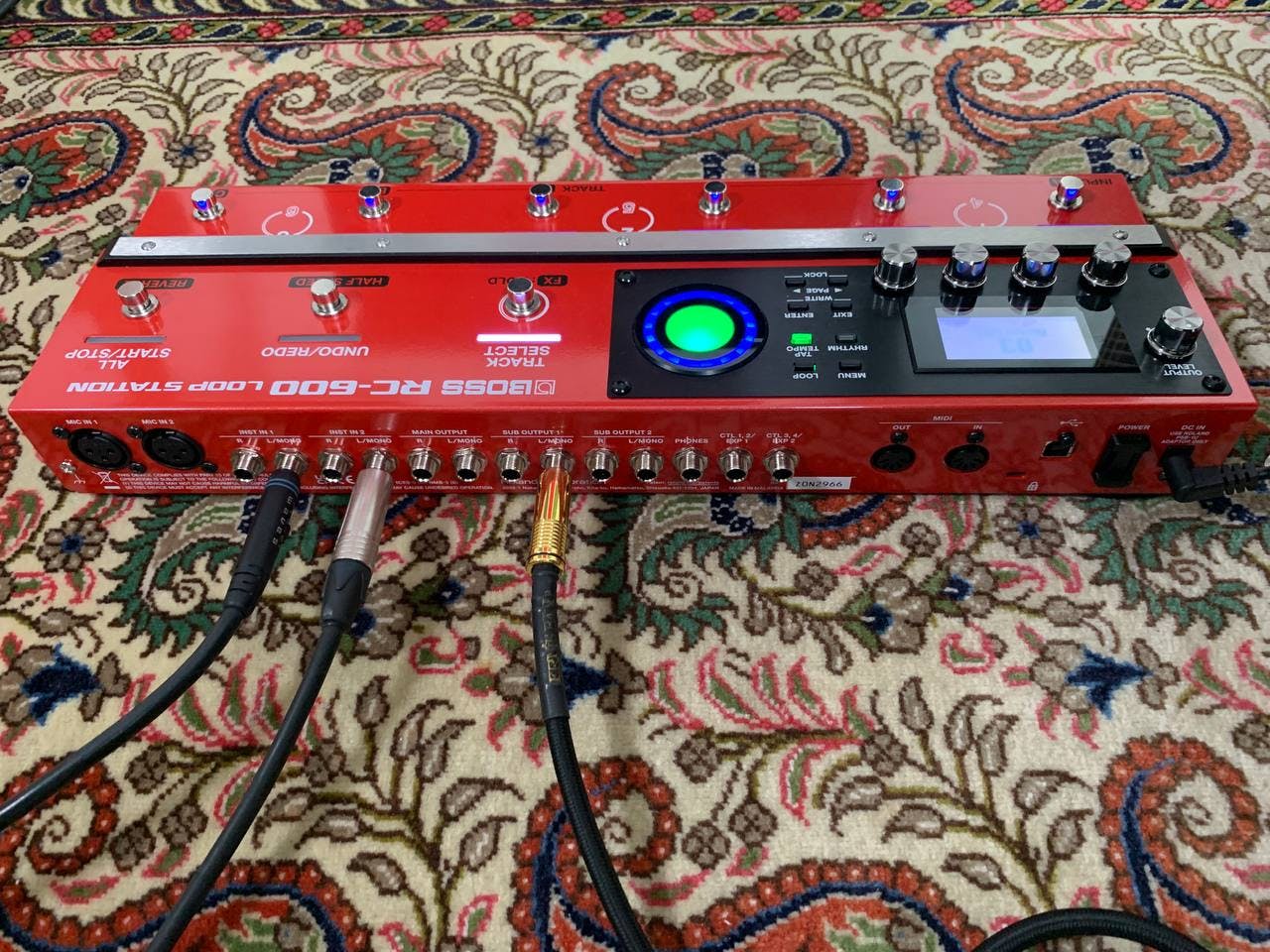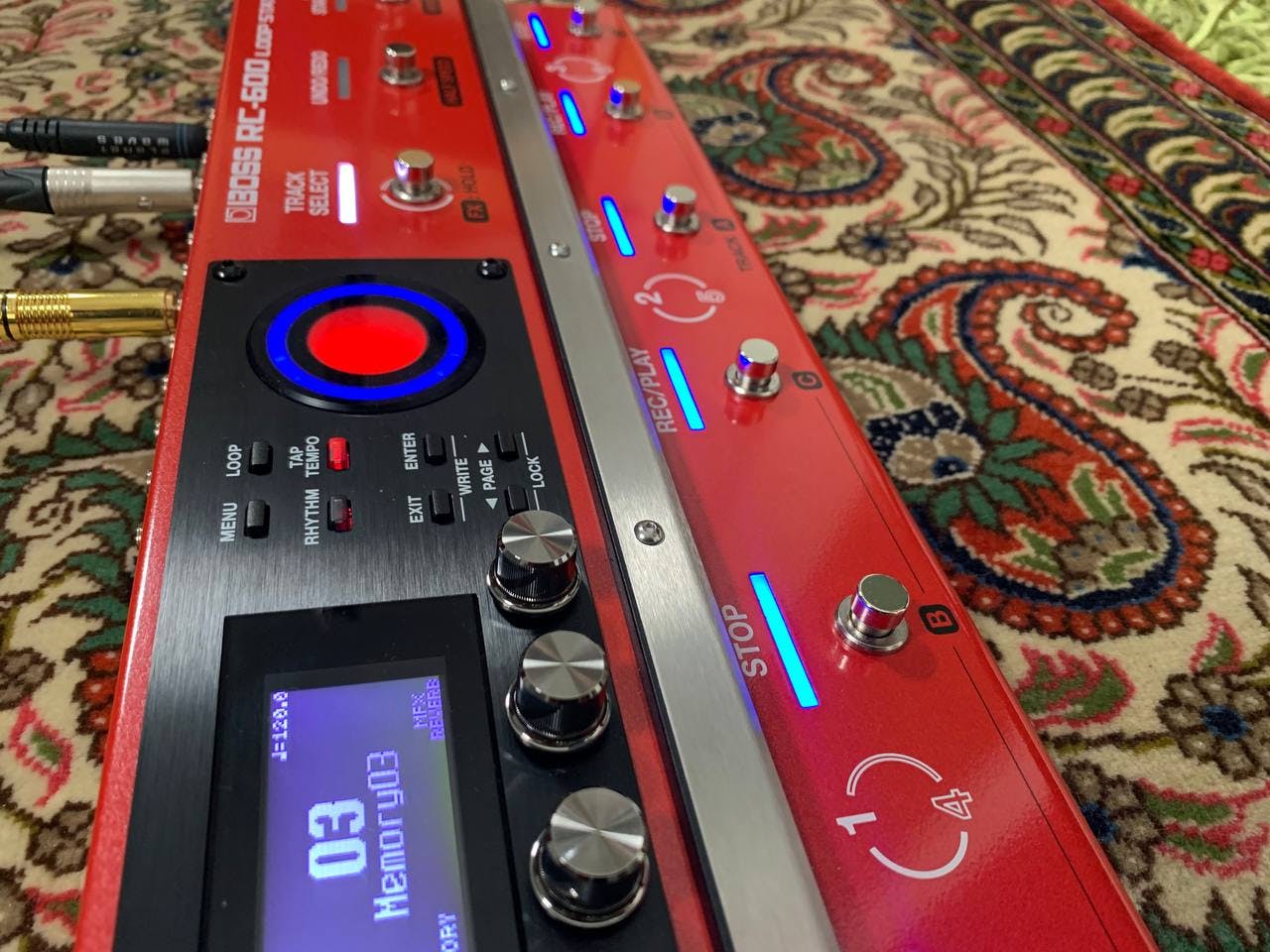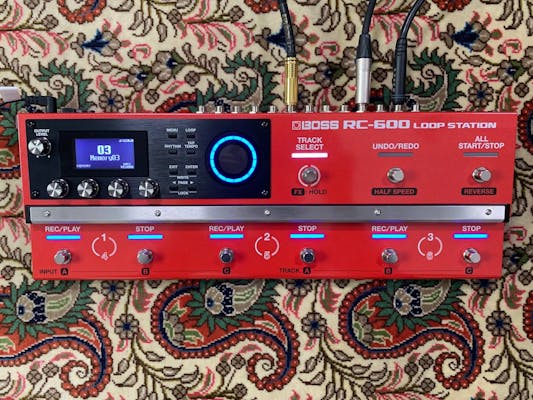Boss RC-600 Loop Station - Test & Review
Boss Introduces New Flagship Looper
In October 2021, Boss has introduced the new flagship model of its looper series. The in December 2021 released Loop Station RC-600, which is available for around £500 (March 2022), is designed as the successor to the now somewhat aged RC-300. In this article, we take a closer look at the features of the new RC-600 and at all the changes compared to the predecessor model.
Features and Specifications
The RC-600 has a red floorboard-style case, measuring 43.5 x 16.3 x 6.6 cm and weighing 2.4 kilograms. The device allows you to record six parallel tracks; several of which can be recorded at once thanks to the multiple connection options. Underneath the casing, the RC-600 works with 32-bit AD/DA converters and operates at 32-bit at 44.1 kHz.
On top of the RC-600, in addition to an LC display, there is a round indicator for the loop status, a rotary control for the output volume, four rotary controls for setting values on the display, and eight small buttons for a variety of different settings. To operate the Loop Station by foot, it has nine foot switches you can basically assign to your liking.
In addition to working as a looper, the RC-600 is also equipped with an exquisite drum machine. Boss didn't really go small with its new Loop Station when it comes to effects either: the RC-600 has 49 effects for input signals and 53 effects to put over the recorded tracks. Recorded tracks can be stored with the selected effect settings on 99 memory slots. You can record about 1.5 hours per track with this looper with the device having a total recording capacity of about 13 hours.
Inputs and Outputs
When looking at the front of the RC-600, you will notice very soon that Boss didn't cut any corners with the inputs and outputs of its new flagship looper. The device comes with two XLR microphone inputs with the option of using phantom power, which you can activate in the settings. This allows you to use condenser microphones for recording. With two stereo inputs in 6.3 mm jack format, you can connect instruments and you can use the left channel for mono signals as well. This equipment of inputs proves that Boss did not only think of guitarists and bass players with its new looper.

In addition to a stereo main output in the format large jack, the RC-600 has two other stereo sub outputs of the same type. With all three stereo outputs, as with the inputs, you can also use the left channel can as a mono connection. Next to the outputs, you can also connect your headphones to a large jack socket on the RC-600. One thing we found a bit unfortunate: You have to do without an XLR output on the RC-600 looper from Boss.
Right next to the headphone jack, the RC-600 has two connectors for external foot switches or pedals such as the Boss FS-5U, FS-6, or EV-5. For integrating the Loop Station into your MIDI setup, the RC-600 has a MIDI input and a MIDI output. You can exchange MIDI signals with a DAW on a PC or Mac via the USB-B port right next to it. Of course, as seen in other Boss devices, the USB port also serves as a USB audio interface and for connecting to Boss Tone Studio, offering you the option of creating backups of your tracks or playing saved tracks to the device.
Other than that, the front of the RC-600 also features a port for the included power adapter and a way to attach a Kensington lock. All in all, the Loop Station has the following connection options:
- 2x XLR microphone input with optional phantom powering
- 2x stereo instrument input (4x 6.3 mm jack)
- 3x stereo output (Main/Sub1/Sub2, R+L/Mono, 6.3 mm jack)
- 1x headphone output (6.3 mm jack)
- 2x connector for external foot switches or expression pedals
- 1x MIDI input
- 1x MIDI output
- 1x USB-B connector
- 1x power share connector
- 1x connector for Kensington lock
Drum Machine
The rhythm section of the RC-600 is very lush offering up to 200 patterns. Each of those rhythm patterns is also available in four different variations. To create an even richer sound variety, Boss equipped the RC-600 drum computer with 16 different drum kits you can apply for each of the patterns. You can also set if intros, outros, and fills should be played.
In our opinion the RC-600's drum machine is an improved version of earlier Boss loopers like the RC-500. We noticed these improvements in the sound. It seems to us that the drum machine on the RC-600 is not just a nice extra feature, but an essential part of its functionality.
The Handling
As with many other modern loopers and effects units, the RC-600's control concept is based on a display combined with knobs to modify the displayed values. We really like the fact that the RC-600 has nine built-in foot switches and that you can freely assign most of them. Each of the foot switches understands a single press as well as a double press or a longer press and hold.
That's why, to most users, the RC-600 should offer more than enough options for foot control, so that additional devices won't be necessary in most cases. In the standard assignment, the lower six foot switches function as record-play and stop buttons for the first three tracks. You can use the track select foot switch above to switch to the last three tracks. There is also a dedicated undo/redo foot switch and another foot switch that starts or stops playback of all tracks. Very handy!
We found another great new feature of the RC-600 to be the round status indicator for loops. A quick look is enough and you will know your position in the loop. Overall, we were satisfied with operating the RC-600. As usual for Boss, the manual goes into detail and is well illustrated. There is also a parameter guide including all possible effects and parameter lists.
Comparison to the RC-300 (previous model)
We found the improvements over the RC-300, the RC-600's predecessor, quite impressive. The RC-300 looper only had three tracks, not six like the RC-600, and instead of the eight large foot switches on the RC-300, the RC-600 now has nine small foot switches. The new looper is much smaller and lighter than its predecessor, and the recording capacity has been increased from 3 to 13 hours - an enormous jump. And let's not forget about the effects: While you had to make do with not more than 16 effects on the RC-300, the RC-600 gives you a mind boggling 49 input and 53 track effects.
There are now two XLR microphone inputs instead of one and the number of instrument inputs has doubled to two. Instead of two stereo outputs, there are now three on the RC-600. Another welcome improvement is the fact that the RC-600 offers 32-bit converter and signal processing instead of the 16-bit of its predecessor

Nevertheless, there are a few things that the 2012 device offers that are no longer present in the RC-600 by Boss. The most noticeable cut is certainly the absence of an expression pedal. However, especially because of this change, the RC-600 has also shrunk significantly in size. As mentioned before, the RC-600 has two microphone inputs, but the hardware switch for phantom power has been eradicated. If you want to activate the phantom power on the RC-600, you have to go to the device settings. The levels of the individual tracks can also only be changed via software settings on the RC-600. Instead, the RC-300 had some handy hardware sliders. Another aspect you can't find in the RC-600: Both the Aux input and the MIDI Thru port have fallen victim to the red pen.
From our perspective, however, the improvements in the RC-600 over its predecessor are so great that buying the unit makes a lot of sense. If you can do without the integrated expression pedal and the few ports that have been cut, the only thing that speaks for the RC-300 is the price, which is around £150 less.
Conclusion
After taking a closer look at the Loop Station RC-600 by Boss, we are convinced that it lives up to its name as the new Boss flagship looper. Except for small drawbacks like the missing XLR output, Boss seems to do everything right with its new looper. The recording capacity of the device is enormous, the number of effects is impressive. Thanks to nine configurable foot switches and expandability via external pedals and MIDI, nothing stands in the way of convenient operation by foot.
We particularly like the fact that you can also use the device, with its six tracks and numerous inputs and outputs, in band applications. In fact, it's even possible to sync two RC-600s via direct MIDI connection, which makes the unit's use a bit more versatile. If you're looking for a looper without any compromises, then it's certainly worth to buy the RC-600 released in December 2021. We, for one, are really happy with it!
This article is a subjective review. We are not liable for the accuracy, timeliness and completeness of the information provided on the linked sites. Particular content displayed on this website originates from Amazon. This content is provided "as is" and may be changed or removed at any time.
Author: Loopstation Team
Publish date: 01.11.2021
Last updated: 07.06.2022
How did you like this review?
4.67 of 5
499 reviews



